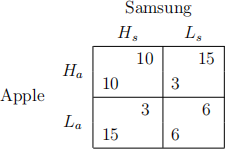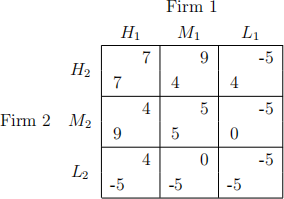ECON 1101 Microeconomics 1
Hello, dear friend, you can consult us at any time if you have any questions, add WeChat: daixieit
Microeconomics 1
ECON 1101
Part A - 100 points Each question in this part is a True, False, or Uncertain question. For each question you must answer whether the statement in italics is True, False, or Uncertain, and justify your response. Each question in this part is worth a maximum of 10 points.
1. Public Schooling in Australia is an example of a public good as it is free to access for all students.
2. Firms hire labour because they gain an inherent benefit from providing jobs to work-ers.
3. Disunited Fruit owns and rents a fleet of apple picking vehicles. Each vehicle is currently valued at $500,000, and depreciates at a rate of 10% per year. True, False, or Uncertain: If Disunited Fruit charged a rental price in excess of $50,000 per vehicle per year, no-one would rent their apple-picking vehicles.
4. Apple and Samsung are competing as duopolists in the smartphone market, each releasing a new smartphone each year. Each year, Apple and Samsung can choose to charge a high price, or a low price, for their new phone. The profits for their choices are given in table below. There is a dominant strategy for each firm to charge a low price (you do not need to show this).

As both firms know this game will be played again every year, there is a way to maintain cooperation.
5. Regardless of costs, a monopoly firm should never produce at a quantity where the price-elasticity of demand is greater than 1.
6. Students asking questions during lectures provides a benefit both to the student asking the question, but also to other students in the class. To improve overall welfare, lecturers should give rewards to those students who ask questions during class.
7. In a competitive market, the supply curve is the same as the marginal cost curve because firms are identical.
8. In order to psychologically manipulate consumers into purchasing more expensive/profitable goods, shopkeepers may stock some products that they do not expect any consumers to actually purchase.
9. Economists tend to like perfectly competitive markets because, assuming there are no externalities, the competitive equilibrium is the efficient outcome.
10. While there are many possible arguments for restricting international trade, in most cases most economists would disagree with these arguments for restricting interna-tional trade.
Part B - 50 points This part contains two questions. Each question in this part is worth 25 points in total. Each question contains multiple sub-questions. As always, you must answer questions to the best of your ability, and justify all responses.
1. The federal government is concerned about rising gas prices for residential consumers due to lower international transport costs driving increased exports. To reduce the domestic price paid by consumers of natural gas, the government is considering three policy options to effect exports: (i) a quota on the amount of gas that can be exported, (ii) a tax applied to all exported gas, and (iii) a consumer subsidy where domestic consumers are subsidised for each unit of gas they consume.
Suppose the autarky price and quantity for natural gas in Australia is $100 per megajoule (MJ), and quantity of 10,000,000 MJ. The world price for gas is $150 per MJ, and at this price Australian consumers demand 5,000,000 MJ, and Australian suppliers supply 15,000,000 MJ. The government wants to reduce the domestic price paid by consumers to only $125 per MJ.
a) Draw a demand-supply diagram showing the autarky, and free trade equilib-rium outcomes prior to government intervention.
b) Show that the desired fall in domestic price paid by consumers can be achieved by (i) an appropriate quota on the amount of gas that can be exported, (ii) an appropriate tax on exported gas, and (iii) an appropriate subsidy paid to consumers for each MJ consumed. Illustrate your solutions with diagrams as needed.
c) Perform a qualitative Welfare Analysis for the introduction of (i) an appropriate quota on the amount of gas that can be exported, (ii) an appropriate tax on exported gas, and (iii) an appropriate subsidy paid to consumers for each MJ consumed. That is, for each policy intervention, describe and show the qualitative change in Consumer Surplus, Producer Surplus, Government Tax Receipts, Total Surplus, and any Deadweight Loss.
d) Using your results from part (c), compare the various policy interventions in terms of their welfare effects.
e) For each policy proposal, describe the cause of each component of Deadweight Loss caused by the policy intervention.
2. Two electricity firms, Firm 1 and Firm 2, are competing in the National Electricity Market by choosing the price to charge for each unit of power they produce. They can each choose to charge a high price (H), a medium price (M), or a low price (L). Charging a low price means they will make almost no revenue on the sale, and so make substantial negative profit. Charging a high or medium price will guarantee some profit, with the level of profit depending on the choice of the other firm. The payoff for each firm depending on their own action, and the action of their opponent, is given in the matrix below.

a) Find all Nash Equilibria for this simultaneous game. Explain why each is a Nash Equilibrium and briefly explain why there are no other Nash Equilibria.
b) Suppose that, instead of acting simultaneously, Firm 1 sets prices first, and Firm 2 chooses it’s price only after seeing the price of Firm 1. Draw the game tree for this sequential game.
c) For the sequential game in part (b), find the unique Subgame Perfect Nash Equilibrium.
d) For the sequential game in part (b), explain why the alternative strategy profile (H1,(M2, L2, L2)) (that is, the profile where Firm 1 sets a high price and Firm 2 sets a medium price if Firm 1 sets a high price, and sets a low price otherwise) is a Nash Equilibrium. Describe the non-credible threat being used in this strategy profile.
e) Returning to the simultaneous game of parts (a) and (b); suppose the firms are not purely strategic players, but are level-k thinkers instead. Recall that a level-0 thinker would choose an action at random. What would be the action of a level-1 player, and why? What would be the action of a level-2 player, and why?
2021-11-06